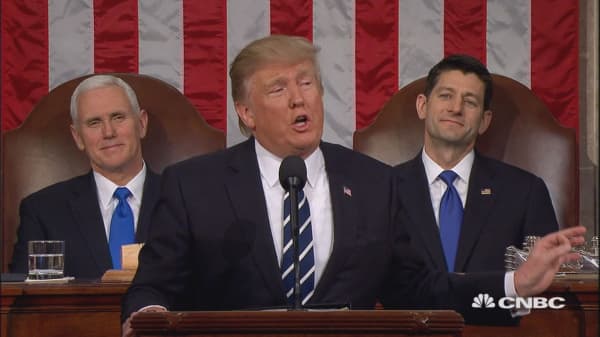In his first Congressional address, President Donald Trump shared a five-point outline of some of the policies he supports for replacing Obamacare. So, we should have more clarity on the suggested replacement plan, right? Wrong.
Unfortunately, we still don't have all the answers. Trump's latest health-care suggestions are not all included in a single Republican plan. Considering Trump picked Tom Price to head the Department of Health and Human Services, it's safe to assume that he considers Price's Empowering Patients First Act as the front-runner. But there are no fewer than three other competing replacement bills put forward by Republicans.
The three plans are: Paul Ryan's A Better Way plan, Bill Cassidy and Susan Collins' Patient Freedom Act of 2017, and Rand Paul's straightforward-named Obamacare Replacement Act.
We don't know which will be chosen, but one thing that does seem clear is that each plan is a bad alternative for the same people: the elderly, the poor, and the sick. In many cases, these groups overlap.
In just about every Republican proposal, the individual mandate — the tax penalty for not having coverage — goes away. Since that penalty helps subsidize the cost for people who do buy insurance, that's not great for making coverage available for everyone. What is also going away are the purchasing assistance subsidies currently in place.
Instead of having purchasing assistance in the form of income-based subsidies, there would be age-based subsidies. That makes sense when you come at it from an angle of the elderly using more health-care services — and having higher bills. But health-insurance affordability isn't just an issue for the elderly; families and young people have trouble, too. Under an age-based subsidy system, older, wealthy people would get purchasing assistance, even though they wouldn't necessarily need it.
Wait — that sounds great for the elderly, doesn't it? Sure, until you look at the age-banding policies that will put in place. Under the ACA, insurers can only charge the elderly (who, again, use more healthcare services and are therefore more costly to insure) up to three times what they charge younger patients. Ryan's plan raises that cap to five times the cost, and the other plans remove it entirely.
So it looks like the elderly may need those subsidies...because of other issues that these same plans would introduce.
Low income health insurance shoppers would lose subsidies, and the Republican answer comes largely in the form of health savings accounts (HSAs) — accounts into which pre-tax dollars can be deposited for healthcare expenses — and tax deductions. These will help, but they're two instruments primarily used by high-income earners.
HSAs require extra income to actually deposit into those accounts. The Cassidy/Collins plan would provide grants or tax credits for this (again, age-based) and Paul's plan would remove annual HSA contribution limits and provide a tax credit of up to $5,000 to go toward HSAs. However, it's not clear that these HSAs would bridge the health insurance affordability gap that millions of consumers face.
And when it comes to making premiums tax deductible, that's another measure that primarily benefits the wealthy: low-income earners who don't make enough to pay taxes — and therefore claim deductions — are out of luck.
Sick people don't make out much better. The ACA introduced 10 essential benefits that every plan must cover; Republican replacement plans repeal this measure, leaving what's covered up to the insurers (although the Cassidy/Collins plan does leave coverage for mental health and substance abuse disorder in place). They argue that's great for, say, young single men who no longer have to pay for maternity coverage that they won't use. But those same young single people are helping to subsidize the cost for people who rely on that maternity coverage.
Then there's the issue of pre-existing condition coverage. The ACA makes discrimination illegal, but Republican plans roll that back to varying degrees. Most have continuous coverage provisions stating that pre-existing conditions can't be discriminated against...as long as the consumer doesn't have a gap in their insurance coverage. If they do, their rates, and insurability, are left to the discretion of the insurer. Paul's plan provides a two-year transition period where no discrimination is allowed, and Ryan has put forth a $25 billion "high-risk pool" to help people who experience a gap in coverage, but it's unclear if these will provide protection to the same extent that the ACA does.
So, when the dust settles, who makes out in all of this? The rich and the healthy, the two groups who need the least amount of help when it comes to affording health insurance. The Republican replacement plans may cost consumers less, but they're also offering less: less coverage, less protection, and less assistance to those who need it most.





